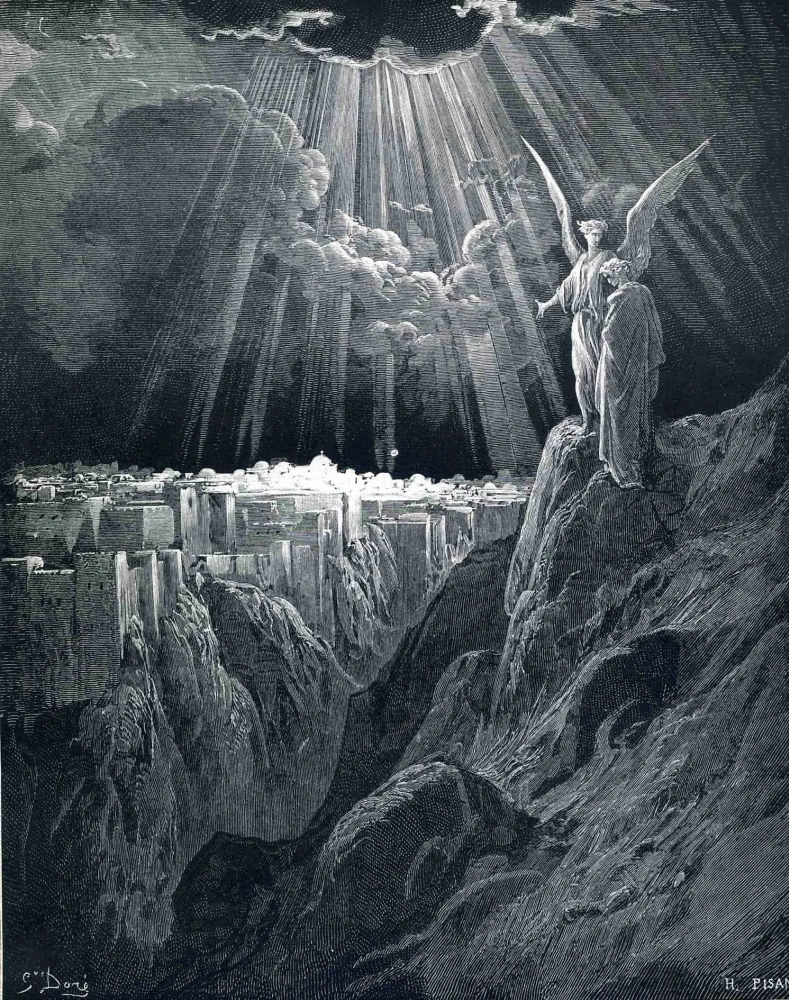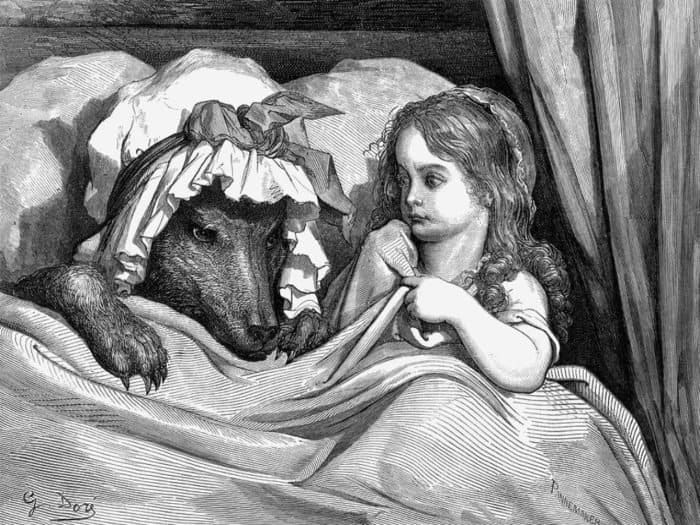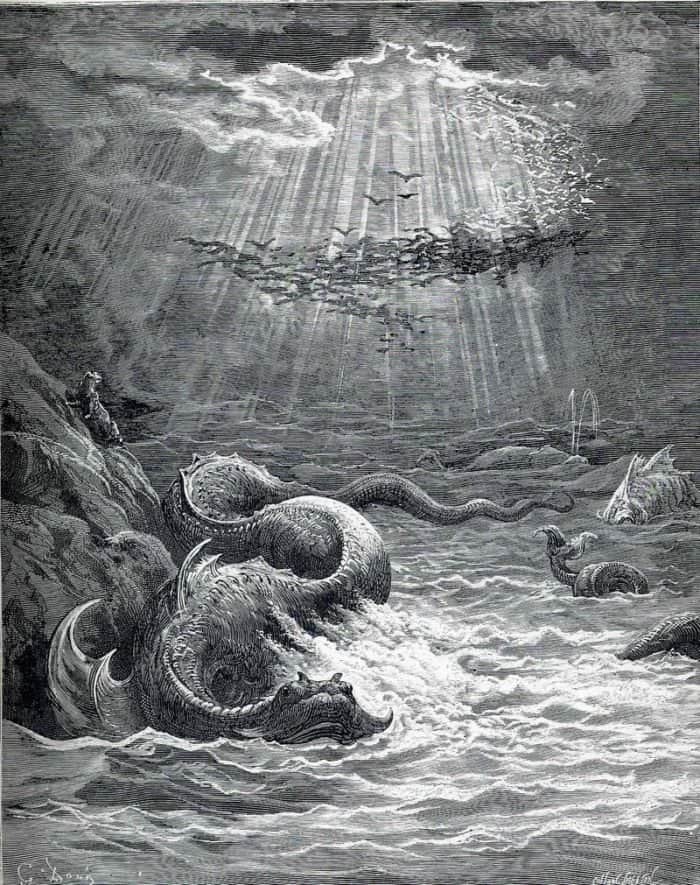Perrault’s Fairy Tale by Charles Perrault, illustrated by Gustave Dore
This collection presents nine famous fairy tales of Charles Perrault: Little Red Riding Hood; Little Thumb; The Sleeping Beauty in the Woods; Cinderella, or The Little Glass Slipper; The Master Cat, or Puss in Boots; Riquet with the Tuft; Donkey Skin; The Fairy; Blue Beard. These tales were created more than 300 years ago; eight of them were included in the collection called Histoires ou contes du temps passé (Stories of Past Times). The book features magnificent engravings by Gustave Doré
«Спящая красавица»
The good woman had never heard of the king’s proclamation
Seeing the towers, the king’s son asked what they were
He turned in the direction of the castle
The figures of men and animals appeared lifeless
Mounting the staircase, he entered the guardroom
Reclining upon a bed was a princess of radiant beauty
Moral:
Many a girl has waited long
For a husband brave or strong;
But I’m sure I never met
Any sort of woman yet
who could wait a hundred years,
Free from fretting, free from fears.
Now, our story seems to show
That a century or so,
Late or early, matters not;
True love comes by fairy-lot.
Some old folk will even say
It grows better by delay.
Yet this good advice, I fear,
Helps us neither there nor here.
Though philosophers may prate
How much wiser’tis to wait,
Maids will be a-sighing still—
Young blood must when young blood will!
«Золушка»
She wondered how a pumpkin could help her get to the ball
Everywhere could be heard «How beautiful she is!»
He perceived that her little foot slid in without trouble
Moral:
Beauty is a treasure rare.
Who complains of being fair?
Yet thereÕs still a something more
That good fairies have in store.
ÔTis that little gift called grace,
Weaves a spell round form and face,
Of each word makes magic, too,
Lends a charm to all you do.
This it wasÑand nothing lessÑ
CinderellaÕs fairy dress!
And if you would learn the way
How to get that gift todayÑ
How to point the golden dart
That shall pierce the PrinceÕs heartÑ
Ladies, you have but to be
Just as kind and sweet as she!
«Кот в сапогах»
Help! the marquis of Carabas is drowing
The cat had taken care to find out who this ogre was
You will all be chopped into little bits like mincemeat
The ogre received him civilly as an ogre can
Moral:
It’s a pleasant thing, I’m told,
To be left a pile of gold.
But there’s something better still,
Never yet bequeathed by will.
Leave a lad a stock of sense—
Though with neither pounds nor pence—
And he’ll finish, as a rule,
Richer than the gilded fool.
«Ослиная шкура»
«Мальчик-с-пальчик»
We can no longer feed our children
In the morning he went to the edge of the brook
On the way he had dropped the little white stones from his pocket
When the children found they were alone they began to cry
They ate with an appetite it did their parents good to see
Little Tom Thumb climbed to the top of the tree
A good dame opened to them
One after another he dragged them from under the bed
He cut the throats of his seven little daughters
Go upstaires and dress those little rascals
He pulled the ogre’s boots off and donned them himself
Moral:
Children are a pride to all
When they’re handsome, straight, and tall.
But how many homes must own
Some odd mite who’s seldom shown—
Just a little palefaced chap,
No One thinks is worth a rap!
Parents brothers laugh him down
Keep him mute with sneer and frown.
Yet it’s Little thumbling may
Bring them fortune one line day!
«Синяя борода»
If you were to open the door,I should be very angry
Her friends were eager to see the splendors of her house
Heaven be praised, they are my brothers
They plunged their swods through his body
Moral:
Ladies, you should never pry,—
You’ll repent it by and by!
‘Tis the silliest of sins;
Trouble in a trice begins.
There are, surely—more’s the woe
Lots of things you need not know.
Come, forswear it now and here—
Joy so brief that costs so dear!
«Красная Шапочка»
In the wood Little Red Riding Hood met the old Father Wolf
He sprang upon the poor old lady and ate her up
She was astonished to see how her grandmother looked
Moral
Little girls, this seems to say,
Never stop upon your way.
Never trust a stranger-friend;
No one knows how it will end.
As you’re pretty, so be wise;
Wolves may lurk in every guise.
Handsome they may be, and kind,
Gay, or charming never mind!
Now, as then, ‘tis simple truth—
Sweetest tongue has sharpest tooth!
«Рике с хохолком»
She saw below what appeared to be a large kitchen full of cooks
Moral:
Here’s a fairy tale for you,
Which is just as good as true.
What we love is always fair,
Clever, deft, and debonair
«Фея»
One day an old woman came and begged for a drink
Moral:
Diamonds and rubies may
Work some wonders in their way;
But a gentle word is worth
More than all the gems on earth.
Moral:
Diamonds and rubies may
Work some wonders in their way;
But a gentle word is worth
More than all the gems on earth
classics-illustrated
На сказках Шарля Перро воспитано не одно поколение. Каждая эпоха по-новому интерпретирует старые сюжеты. В сегодняшней пестроте изданий сказок Перро очень трудно найти книгу, в которой текст великого сказочника не был бы искажен до неузнаваемости, а иллюстрации радовали глаз. Не так давно выходили книги сказок с иллюстрациями Дехтерева и Рейпольского, которые были хороши всем, кроме полноты содержания. Поэтому вышедшая буквально на днях в издательстве Снег книга «Волшебные сказки» — просто подарок ценителям сказок Перро.
Появление на рынке этой книги вызвало небывалый резонанс, и я решила после анонса написать отдельный пост.

фотографии взяты с сайта издательства
От издателя: 120 страниц, мелованная бумага, твердый переплет с золотым тиснением, тиснение фольгой, ляссэ. Формат книги 295-235 мм. Тираж 2500 экземпляров.
Содержание: Красная Шапочка, Мальчик-с-Пальчик, Спящая Красавица, Замарашка, Кот в Сапогах, Хохлик, Ослиная Кожа, Волшебница, Синяя Борода.
Этот сборник сказок — уникальная подарочная книга — чудесный качественный репринт антикварного издания 1867 года книгопродавца и типографа Маврикия Вольфа, которое было им подарено самой Государыне Императрице. Три великих мастера создали великую книгу: Шарль Перро — автор, Иван Тургенев — переводчик, Гюстав Доре — иллюстратор. При всем многообразии художников, проиллюстрировавших сказки Шарля Перро, только гравюры выдающегося французского графика, иллюстратора и живописца Гюстава Дорэ для меня навсегда останутся непревзойденными. Эти иллюстрации были созданы в 1862 году и по праву считаются лучшими. Признание Дорэ уже в его эпоху было феноменальным. В 60-х годах ХIХ века каждый автор, который писал книгу, хотел, чтобы ее иллюстрировал Дорэ, каждый издатель, который публиковал книгу, стремился сопроводить ее иллюстрациями Дорэ. Так что издательству, решившему в 1862 году выпустить сборник сказок Шарля Перро, несказанно повезло. Как и тем детям, которые уже полтора столетия могут разглядывать эти полные одновременно фантазии и натуралистичности рисунки. В 1867 году у рисунков появился цвет, качество передачи которого в сегодняшнем переиздании не может не радовать. К тому же в книге используется наиболее близкий к первоисточнику перевод с французского выдающегося русского писателя Ивана Сергеевича Тургенева.
Дебаты во френдленте разразились на тему хороши или плохи цветные иллюстрации по сравнению с оригинальными черно-белыми. Мое мнение — хороши по своему. Черно-белые гравюры оставляют больше места для фантазии, но дети до определенного возраста лучше воспринимают и усваивают информацию в цвете. Главное, что в этой книге гравюры грамотно «раскрашены». Не так, как желтушный Кот-китаец того же Дорэ в недавнем издании от АСТ. Чтобы вы случайно не купили — вот оно:
Поскольку гравюра появилась задолго до литографии, о тиражировании разноцветных картинок в то время и не мечтали. Но многие художники воспринимали вынужденную монохромность как ограниченность самовыражения, именно из-за отсутствия выбора. Поэтому гравюры стали раскрашивать вручную. При грамотном подходе, который в данном издании мы и имеем, раскрашенная гравюра смотрится великолепно.
В комментариях было замечено, что введение цвета может смещать акцент, и в качестве примера даны две фотографии, к сожалению, не слишком качественные, но других пока нет. Цвет смещает нужные акценты только если не верно использован. К примеру, обесцветьте любую хорошую работу, и ничего не изменится в плане восприятия главного и второстепенного за счет тона и светотени. Посмотрите сами.
Вопрос был — смещен ли в цветовом решении акцент с глаз на бороду. Я думаю, нет. Глаза по-прежнему достаточно выразительны. Усомнившись в своей правоте несмотря на двадцать с лишним лет художественного образования, спросила мужа. Он художник в четвертом поколении. Сказал: качество фото и сканов плохое, но на первый взгляд, раскрасили отлично. Были также опрошены все заходившие в гости друзья-художники. Нареканий книга ни у кого не вызвала. Более того — сказали, что красота! По центру — фото из книги 2008 года издания от «Игры слов» с черно-белыми иллюстрациями. Справа — из новой цветной, слева — то же, обесцвеченное.
фото из разных источников, которые к сожалению не сохранились
Подводя итог хочу сказать, что красивы и черно-белые и цветные иллюстрации Дорэ, но ценность книги в том, что это превосходное воспроизведение антикварного издания. Поэтому я ее жду не дождусь. И всем советую. К тому же цена в Озоне всего 1550 руб. (В Торговом Доме Книги «Москва» — 1850 руб, а больше нигде и нет)
Сказала о цене, потому как из доступного Дорэ в хорошем исполнении сегодня в продаже только набор открыток от ИДМ, в который входят открытки к следующим сказкам: Ослиная шкура, Синяя борода, Спящая красавица, Мальчик-с-пальчик, Золушка, Кот в сапогах, Красная шапочка, Хохлик и Волшебница.
Есть еще подарочные издания с космическими ценами (по нарастающей), но простым смертным это не по плечу:
Доре повезло. Ему выпало жить во времена научно-технического бума. Именно в шестидесятые годы получила развитие фотомеханическое воспроизведение ксилографий (гравюр на дереве) по цинковым клише — гальванокопирование.
Известный петербургский книгоиздатель М. О. Вольф заказывал подлинные доски из Парижа у Мама, собственника рисунков Доре. Именно Вольф в 1874 году впервые в России опубликовал полный русский перевод «Божественной комедии» с иллюстрациями Доре. Книга это имела не просто успех, Доре вошел в моду, а Вольф на этом неплохо заработал.
К моменту начала работы над «Божественной комедией» Доре уже достиг определенных высот на этом поприще: в его портфолио были успешные кейсы по созданию иллюстраций для произведений Франсуа Рабле, Джорджа Байрона, а также Библии.
Доре было всего 23 года, когда он затеял амбициозный проект по созданию гравюр для бессмертной поэмы Данте.
Несмотря на репутацию самого высокооплачиваемого иллюстратора Франции, ему все же не удалось убедить своего издателя выделить финансирование для этого замысла. Тогда художник решил выпустить первый том за собственные средства.
Когда в 1861 году «Ад» с с его иллюстрациями увидел свет, то весь тираж мгновенно исчез с полок магазинов. Вопрос о финансировании других томов уже не стоял, и к 1868 году вышли остальные части «Божественной комедии» с рисунками Доре, ставшей мгновенной классикой. В общей сложности он создал около полутора сотен гравюр к произведению Данте.
Оригинальный, веселый, энергичный Доре был невероятно плодовит и за раз делал до двадцати рисунков на досках (ксилография тогда вошла в моду), обеспечивая работой полсотни граверов. Сериями выходили из под его рук рисунки — живые, содержательные, демонстрирующие талант Доре-наблюдателя.
Число авторов, которые мечтали, чтобы их бессмертные произведения проиллюстрировал Доре, просто зашкаливало, от заказов не было отбоя.
Но для себя художник решил, что прежде проиллюстрирует самые значительные произведения мировой литературы. В шестидесятые годы он создает рисунки к сказкам Шарля Перро, «Дон Кихоту» Сервантеса, Басням Лафонтена, произведениям Виктора Гюго, Джона Мильтона, Шатобриана. Как писала его друг и биограф Джеррольд, число иллюстраций, сделанных Доре, уже к 1862 году достигало сорока с лишним тысяч. А ведь впереди еще был «Дон Кихот».
Кстати, за впечатлениями Доре ездил в Испанию дважды: в 1855 и в 1862 году (тогда он собирал материал и делал зарисовки).
Его Дон Кихот потряс публику не меньше дантевского «Ада», ведь он был непохож на все те образы, которые в течение трехсот лет создавались художниками.
В отличие от многих, Доре увидел в Дон Кихоте не «рыцаря печального образа, созданного ради осмеяния старинных рыцарских романов», а благородного гуманиста, живущего ради других и во имя спасения человечества от зла. Как и иллюстрации к «Божественной комедии», «Дон Кихот» вошел в анналы изобразительного искусства и до сих пор считается непревзойденным.
Источник: foma.ru
Статья проиллюстрирована изображениями картин из Интернета
Perrault’s Fairy Tale by Charles Perrault, illustrated by Gustave Dore
This collection presents nine famous fairy tales of Charles Perrault: Little Red Riding Hood; Little Thumb; The Sleeping Beauty in the Woods; Cinderella, or The Little Glass Slipper; The Master Cat, or Puss in Boots; Riquet with the Tuft; Donkey Skin; The Fairy; Blue Beard. These tales were created more than 300 years ago; eight of them were included in the collection called Histoires ou contes du temps passé (Stories of Past Times). The book features magnificent engravings by Gustave Doré
«Спящая красавица»
The good woman had never heard of the king’s proclamation
Seeing the towers, the king’s son asked what they were
He turned in the direction of the castle
The figures of men and animals appeared lifeless
Mounting the staircase, he entered the guardroom
Reclining upon a bed was a princess of radiant beauty
Moral:
Many a girl has waited long
For a husband brave or strong;
But I’m sure I never met
Any sort of woman yet
who could wait a hundred years,
Free from fretting, free from fears.
Now, our story seems to show
That a century or so,
Late or early, matters not;
True love comes by fairy-lot.
Some old folk will even say
It grows better by delay.
Yet this good advice, I fear,
Helps us neither there nor here.
Though philosophers may prate
How much wiser’tis to wait,
Maids will be a-sighing still—
Young blood must when young blood will!
«Золушка»
She wondered how a pumpkin could help her get to the ball
Everywhere could be heard «How beautiful she is!»
He perceived that her little foot slid in without trouble
Moral:
Beauty is a treasure rare.
Who complains of being fair?
Yet thereÕs still a something more
That good fairies have in store.
ÔTis that little gift called grace,
Weaves a spell round form and face,
Of each word makes magic, too,
Lends a charm to all you do.
This it wasÑand nothing lessÑ
CinderellaÕs fairy dress!
And if you would learn the way
How to get that gift todayÑ
How to point the golden dart
That shall pierce the PrinceÕs heartÑ
Ladies, you have but to be
Just as kind and sweet as she!
«Кот в сапогах»
Help! the marquis of Carabas is drowing
The cat had taken care to find out who this ogre was
You will all be chopped into little bits like mincemeat
The ogre received him civilly as an ogre can
Moral:
It’s a pleasant thing, I’m told,
To be left a pile of gold.
But there’s something better still,
Never yet bequeathed by will.
Leave a lad a stock of sense—
Though with neither pounds nor pence—
And he’ll finish, as a rule,
Richer than the gilded fool.
«Ослиная шкура»
«Мальчик-с-пальчик»
We can no longer feed our children
In the morning he went to the edge of the brook
On the way he had dropped the little white stones from his pocket
When the children found they were alone they began to cry
They ate with an appetite it did their parents good to see
Little Tom Thumb climbed to the top of the tree
A good dame opened to them
One after another he dragged them from under the bed
He cut the throats of his seven little daughters
Go upstaires and dress those little rascals
He pulled the ogre’s boots off and donned them himself
Moral:
Children are a pride to all
When they’re handsome, straight, and tall.
But how many homes must own
Some odd mite who’s seldom shown—
Just a little palefaced chap,
No One thinks is worth a rap!
Parents brothers laugh him down
Keep him mute with sneer and frown.
Yet it’s Little thumbling may
Bring them fortune one line day!
«Синяя борода»
If you were to open the door,I should be very angry
Her friends were eager to see the splendors of her house
Heaven be praised, they are my brothers
They plunged their swods through his body
Moral:
Ladies, you should never pry,—
You’ll repent it by and by!
‘Tis the silliest of sins;
Trouble in a trice begins.
There are, surely—more’s the woe
Lots of things you need not know.
Come, forswear it now and here—
Joy so brief that costs so dear!
«Красная Шапочка»
In the wood Little Red Riding Hood met the old Father Wolf
He sprang upon the poor old lady and ate her up
She was astonished to see how her grandmother looked
Moral
Little girls, this seems to say,
Never stop upon your way.
Never trust a stranger-friend;
No one knows how it will end.
As you’re pretty, so be wise;
Wolves may lurk in every guise.
Handsome they may be, and kind,
Gay, or charming never mind!
Now, as then, ‘tis simple truth—
Sweetest tongue has sharpest tooth!
«Рике с хохолком»
She saw below what appeared to be a large kitchen full of cooks
Moral:
Here’s a fairy tale for you,
Which is just as good as true.
What we love is always fair,
Clever, deft, and debonair
«Фея»
One day an old woman came and begged for a drink
Moral:
Diamonds and rubies may
Work some wonders in their way;
But a gentle word is worth
More than all the gems on earth.
Moral:
Diamonds and rubies may
Work some wonders in their way;
But a gentle word is worth
More than all the gems on earth
classics-illustrated






















































